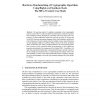Free Online Productivity Tools
i2Speak
i2Symbol
i2OCR
iTex2Img
iWeb2Print
iWeb2Shot
i2Type
iPdf2Split
iPdf2Merge
i2Bopomofo
i2Arabic
i2Style
i2Image
i2PDF
iLatex2Rtf
Sci2ools
ARC
2015
Springer
2015
Springer
Hardware Benchmarking of Cryptographic Algorithms Using High-Level Synthesis Tools: The SHA-3 Contest Case Study
The growing number of candidates competing in the cryptographic contests, such as SHA-3, makes the hardware performance evaluation extremely time consuming, tedious, and imprecise, especially in the early stages of the competitions. The main difficulties include the long time necessary to develop and verify HDL (hardware description language) codes of all candidates, and the need of developing (or at least tweaking) codes for multiple variants and architectures of each algorithm. High-level synthesis (HLS), based on the newly developed Xilinx Vivado HLS tool, offers a potential solution to the aforementioned problems. In order to verify a potential validity of this approach, we have applied our proposed methodology to the comparison of five Round 3 SHA-3 candidates. Our study has demonstrated that despite a noticeable performance penalty, caused by the use of high-level synthesis tools vs. manual design, the ranking of the evaluated candidates, in terms of four major performance metr...
| Added | 16 Apr 2016 |
| Updated | 16 Apr 2016 |
| Type | Journal |
| Year | 2015 |
| Where | ARC |
| Authors | Ekawat Homsirikamol, Kris Gaj |
Comments (0)

